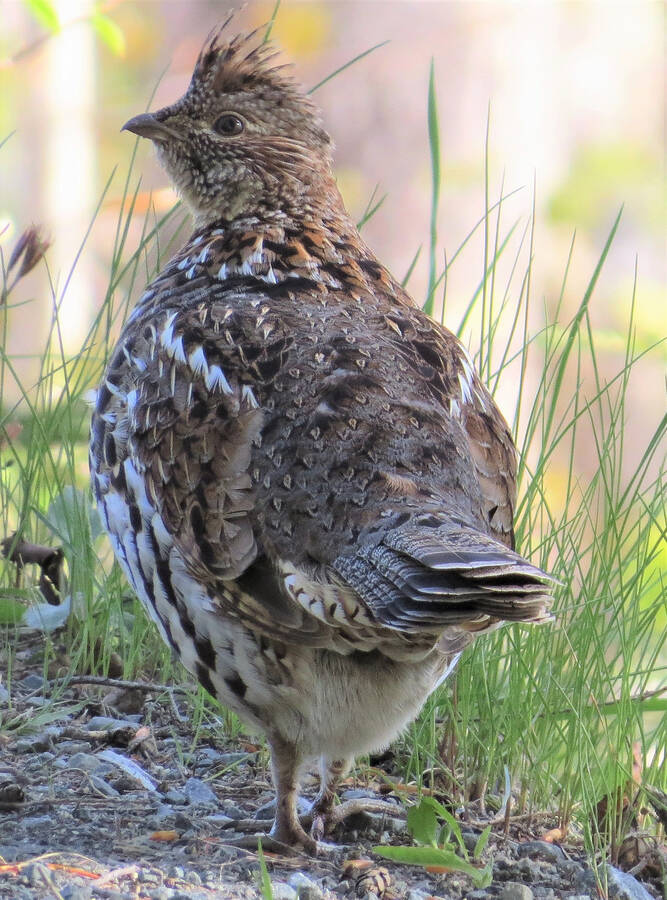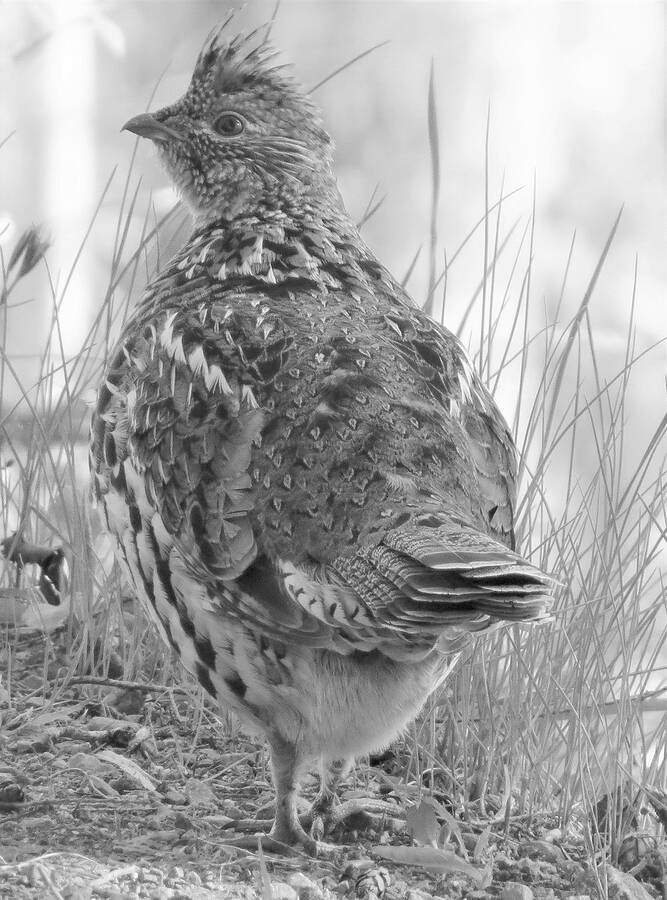
2023-05-31
The ruffed grouse
On May 14, I went on a bird outing with my friend David Walmark to the Somerset Road. We were graced with seeing a ruffed grouse on side of the road, which remained in place for a long time. Usually these birds are very flighty and flush quickly.
The ruffed grouse lives as a resident in Alaska, the Yukon, and into Saskatchewan, Manitoba, Ontario, Quebec, Labrador and Newfoundland, New Brunswick and Nova Scotia south to California, Oregon, Idaho, Utah, Colorado, Wyoming, South Dakota, Minnesota, in Nebraska, Kansas, Arkansas, Ohio, Tennessee, Alabama, Georgia, South Carolina, North Carolina, West Virginia, Virginia, Maryland, Wisconsin, Michigan, New York, New England, Pennsylvania, New Jersey, Kentucky, Missouri, Illinois, and Indiana.
The ruffed grouse is 37.5 to 47.5 cm long with a wingspread of 55 to 62.5 cm. There are two colour phases, one red and the other grey. The adult male is usually larger and heavier than the female. Both sexes have ruff feathers that form a triangular patch on each side of the neck and they could be labelled as chicken-like birds.
They have a finely barred rather long fan-shaped tail with broad black bars near the tip. In the breeding season the male has a bright orange-colored comb over the eyes. They often are heard drumming their wings on a log announcing their territory.
The ruffed grouse eats cutworms, grasshoppers, beetles, ants, wasps, spiders and caterpillars as well as other insects. They eat wild berries, apples, plums, wild grapes, and nuts and also seeds of hemlocks, maple trees, and tick trefoil, beggar's-ticks, and many other weed seeds.
They also consume blossoms and buds or leaves of poplar, birch, willow, apple, pear, peach, alder, spruce, spice bush and many other small herbaceous plants. The adults will also occasionally eat garter snakes, red-bellied snakes, frogs and toads.
The Global Big Day took place on May 13, with 647,000 people identifying birds with the Merlin Bird ID. Some 148,270 checklists were submitted and there were 58,756 eBirders from 199 countries. Species recorded were 7,636 and 72,561 photos of 3,667 species were sent in.
In Canada, there were 6,287 participants of 398 species. Provinces with the most species were British Columbia 262, Ontario 262, Alberta 234, Quebec 234, Manitoba 226, Saskatchewan 206, New Brunswick 175, Nova Scotia 170, Yukon Territory 120 and Newfoundland and Labrador 98.
Nova Scotia submitted 741 checklists. The counties with the most species were Halifax with 126, Pictou 118, Lunenburg 101, Yarmouth 93, Kings 89, Annapolis 88, Shelburne 88, Guysborough 83, Cumberland 81 and Hants 77. For Lunenburg County, 77 checklists were submitted with 31 people participating.
I led a field trip for the Nova Scotia Bird Society at Cape Sable Island on May 20. Including myself there were 18 people. We found 42 species on the field trip. Highlights were the piping plover, blue-winged teal, gadwall and bay-breasted warbler. A turkey vulture, as always, was a treat.
Paul Clarke noted a bald eagle at Oxner's Beach in Lower LaHave and also reported three great blue herons there. Bonnie Whynott of Middlewood and Steven Hiltz of Back Centre both had Baltimore orioles, which fed at their hummingbird feeders and also at the orange halves they had put out.
Across the province, notable birds were a Say's Phoebe and gray-cheeked thrush reported by Diane Leblanc at Sandy Cove Beach on May 13. On May 18, Kathleen MacAulay located a sedge wren at Sunday Point. Ronnie d'Entremont reported both a red-headed woodpecker and a red-bellied woodpecker at Chebogue Road on May 17. May 18 produced a white-crowned sparrow and an indigo bunting at Chasewood for Blaine MacDonald.
On May 20, Wayne Green found a mute swan at Fisherman's Reserve. On that day, Ervin Olsen was lucky in finding a hooded warbler at Quinnan and Ellis d'Entremont discovered a red phalarope at Pond Road in Pubnico. Ronnie d'Entremont had a blue-grey gnatcather at The Willows. A summer tanager was a nice find by Thomas Bruce at the Frog Pond in Halifax on May 21. On May 24, Angela Macdonald found a Carolina wren at Sherbrooke Village.
You may reach me at (902) 693-2174 or email jrhbirder@hotmail.com.








